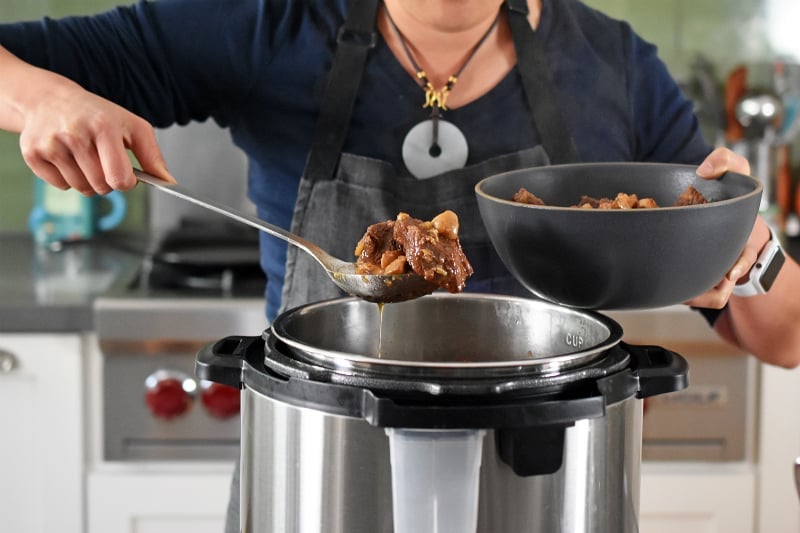How to Cook Pasta in Pressure Cooker: A Step-by-Step Guide to Perfectly Cooked Pasta
Written By James Morgan
If you're wondering how to cook pasta in a pressure cooker, you've come to the right place. Cooking pasta can sometimes be a tedious job, especially when you have to cook it on the stove and constantly monitor the boiling water. The good news is that a pressure cooker can make this process much faster and more efficient. In this detailed guide, we'll walk you through the steps and tips to create perfectly cooked pasta using a pressure cooker. Whether you're a beginner or a pasta aficionado, you'll find valuable tips and insights that will make your cooking experience smoother and more enjoyable. source.
:max_bytes(150000):strip_icc()/Instant-Pot-Duo-Evo-Plus-2000-78b1640b28324a59b7dcba0603483e3b.jpg)
Why Use a Pressure Cooker?
A pressure cooker is a versatile kitchen tool that can save you time and energy when cooking different meals, including pasta. One of the significant advantages of using a pressure cooker is the reduced cooking time. By sealing in steam, it allows food to cook faster than traditional methods. Additionally, a pressure cooker helps to retain more nutrients and flavors in your food, making your meals not just quicker, but also tastier and more nutritious. For busy individuals and families, the pressure cooker is a game-changer in the kitchen.

Essential Ingredients and Cooking Tools
- Pasta of your choice (e.g., spaghetti, penne, fusilli)
- Water or broth
- Salt
- Olive oil or butter
- Sauce (optional)

Step-by-Step Instructions
Step 1: Prepare Your Ingredients
Before starting, gather all the ingredients you need. Measure the pasta, water or broth, and any seasonings like salt and olive oil. The quantity of the pasta will determine how much liquid you'll need. As a general rule, you'll need about 2 cups of water for every cup of pasta. If you prefer your pasta with a bit of sauce, you can also prepare or choose a store-bought sauce for later use. This step is crucial for ensuring a smooth and uninterrupted cooking experience. Be sure to use a high-quality pressure cooker to achieve the best results.
Step 2: Add Ingredients to the Pressure Cooker
Once you have everything ready, pour the water or broth into the pressure cooker. Add a pinch of salt and a tablespoon of olive oil or butter to enhance the flavor of the pasta. Next, add the pasta to the liquid. Make sure the pasta is fully submerged to ensure even cooking. If you're cooking a large batch, you may need to adjust the amount of liquid accordingly. Cover the pressure cooker with its lid and ensure it's sealed correctly. This is an important step to prevent any steam from escaping, which could affect the cooking time and quality of the final dish.
Step 3: Pressure Cook the Pasta
Set the pressure cooker to high pressure and set the timer based on the type of pasta you're cooking. Generally, it takes about 4-6 minutes to cook pasta under high pressure. However, the cooking time may vary depending on the type of pasta and your personal preference for its doneness. Once the cooking time is up, let the pressure release naturally for about 5 minutes before manually releasing any remaining pressure. This step ensures that the pasta is perfectly cooked and not overdone. Exercising caution during this step is essential to avoid any mishaps or burns from the hot steam.
Step 4: Check and Finish the Pasta
After releasing the pressure, carefully open the lid of the pressure cooker. Check if the pasta is cooked to your liking. If it's not quite done, you can cook it for an additional minute or two. If the pasta is perfect, drain any excess water if necessary, and stir in your preferred sauce. Toss the pasta gently to ensure the sauce coats each piece evenly. This step is where you can get creative and add other ingredients such as cheese, herbs, or spices to enhance the flavor of your pasta.

Tips for Perfect Pasta Every Time
Cooking pasta in a pressure cooker is relatively straightforward, but a few tips can go a long way in ensuring perfection every time. First, avoid overfilling the pressure cooker; leave some space for the pasta to expand. Second, always follow the recommended cooking times and pressures for different types of pasta. Third, release pressure slowly to prevent content splattering everywhere. Lastly, always use a high-quality pressure cooker and keep it well-maintained for consistent results.
Conclusion
Mastering how to cook pasta in a pressure cooker can elevate your culinary skills and save you precious time in the kitchen. This guide offers all the insights and steps to help you achieve perfectly cooked pasta without the hassle of constant monitoring. Remember to experiment with different types of pasta and sauces to find what suits your taste best. Happy cooking!
As an Amazon Associate, I earn from qualifying purchases.



